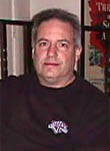|
|
 
|
|
Author
|
Topic: Keystone Moviegraph
|
Paul G. Thompson
The Weenie Man

Posts: 4718
From: Mount Vernon WA USA
Registered: Nov 2000
|
 posted 04-10-2001 01:51 AM
posted 04-10-2001 01:51 AM




I have one of these sitting next to my dog. It is a Keystone MovieGraph, Model No. 147 W, Serial Number 55107 and and patent number 1345793. It has 5-inch reels, and is a hand cranked chain driven machine. It is a 35mm projector, using a 200-watt clear incandescent bulb. It was made in Boston, U.S.A Anyone ever heard of those critters? Looking the patent number up on the web, it was applied for on 17 October 1919 and issued on July 6, 1920 to Isidore Marks, of Boston Massachusetts, assignor to Keystone Manufacturing Company. If you looked up the number, there is a drawing of this machine, minus a few minor details. That thing might be older than I thought. I wonder what it is worth, it is in very good condition.
| IP: Logged
|
|
|
|
|
|
|
|
John Schulien
Expert Film Handler

Posts: 206
From: Chicago, IL, USA
Registered: Nov 1999
|
 posted 04-10-2001 11:21 AM
posted 04-10-2001 11:21 AM




I have one also. I found mine on ebay and paid about $60 for it. Mine was in very rough condition though. I saw a mint example go by on ebay without reaching reserve ... I think that the bidding went into the $150+ range.The interesting thing about those projectors was where the films came from. Rather than have special films made, the manufacturer cut a deal with a film depot -- he would take their junked prints, cut them into 100' segments, and sell them along with the projectors. Two interesting side effects. First, the kiddies got NITRATE film to play in their toy projectors!  Second, fragments of some lost silent movies may have survived this way. My projector came with clips from three movies. An unknown silent western from 1923, part of an original print of a Buster Keaton short, and a clip from an unknown western/drama. The third one is the most interesting. The picture filmstock has no edge printing, but the intertitle stock, which is spliced, not printed, into the film, has a date code of single-rectangle, which probably dates the film to 1917! All of these nitrate films have shrunk about 3%, but otherwise have no signs of deterioration. They are strong, flexible, with no signs of stickiness or breakdown with the exception of about two feet of the 1917 reel.
| IP: Logged
|
|
|
|
|
|
John Pytlak
Film God

Posts: 9987
From: Rochester, NY 14650-1922
Registered: Jan 2000
|
 posted 04-10-2001 01:45 PM
posted 04-10-2001 01:45 PM





Here are some links to Kodak information about nitrate film:
http://www.kodak.com/country/US/en/motion/support/environment/nitrate.shtml
http://www.kodak.com/country/US/en/motion/support/technical/storage1.shtml The Chronology of Kodak Motion Picture films lists the history of the transition from flammable nitrate film base:
http://www.kodak.com/country/US/en/motion/about/chrono1.shtml 1909 First public announcement of Eastman Safety Acetate Support based on
successful burning test results vs. Nitrate Support. 1910 First Safety Film (acetate) offered for sale in 22mm. 1923
Kodak made amateur motion pictures practical with the introduction of 16 mm
reversal film on cellulose acetate (safety) base, the first 16 mm CINE-KODAK
Motion Picture Camera, and the KODASCOPE Projector. The immediate
popularity of 16 mm movies resulted in a network of Kodak processing
laboratories throughout the world.
1948 Safety Base developed to replace Nitrate Base Films.
Kodak announced a 35 mm tri-acetate safety base film for the motion picture
industry to replace the flammable cellulose nitrate base.
Conversion from Nitrate to Safety Base begins, complete conversion takes
approximately 4 years. 1949 Improved Safety Base Motion Picture Film -- Awarded OSCAR --(22nd Academy
Year) Class I. Scientific or Technical Award 1950 EASTMAN Fine Grain Release Positive film,
5302. Safety base replacement for 1302. (B&W)
Replace nitrate with acetate.
EASTMAN Fine Grain Duplicating Film, 5365.
Replaced 1365 (nitrate).
EASTMAN Fine Grain Panchromatic Duplicating
Film, 5203. Replaced 1203 (nitrate). ------------------
John P. Pytlak, Senior Technical Specialist
Worldwide Technical Services, Entertainment Imaging
Eastman Kodak Company
Research Labs, Building 69, Room 7419
Rochester, New York, 14650-1922 USA
Tel: 716-477-5325 Cell: 716-781-4036 Fax: 716-722-7243
E-Mail: john.pytlak@kodak.com
Web site: http://www.kodak.com/go/motion
| IP: Logged
|
|
|
|
|
|
|
|
All times are Central (GMT -6:00)
|
|
Powered by Infopop Corporation
UBB.classicTM
6.3.1.2
The Film-Tech Forums are designed for various members related to the cinema industry to express their opinions, viewpoints and testimonials on various products, services and events based upon speculation, personal knowledge and factual information through use, therefore all views represented here allow no liability upon the publishers of this web site and the owners of said views assume no liability for any ill will resulting from these postings. The posts made here are for educational as well as entertainment purposes and as such anyone viewing this portion of the website must accept these views as statements of the author of that opinion
and agrees to release the authors from any and all liability.
|

 Home
Home
 Products
Products
 Store
Store
 Forum
Forum
 Warehouse
Warehouse
 Contact Us
Contact Us




 Printer-friendly view of this topic
Printer-friendly view of this topic
















